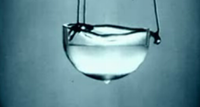
Photo from wikipedia
We present a theoretical description of energy transfer processes between two noncontact quasi-twodimensional crystals separated by distance a, oscillating with frequency ω0 and amplitude ρ0, and compare it with the… Click to show full abstract
We present a theoretical description of energy transfer processes between two noncontact quasi-twodimensional crystals separated by distance a, oscillating with frequency ω0 and amplitude ρ0, and compare it with the case of two quasi-two-dimensional crystals in uniform parallel motion. We apply the theory to calculate van der Waals energy and dissipated energy in two oscillating slabs where each slab consists of a graphene monolayer deposited on SiO2 substrate. The graphene dielectric response is determined from first principles, and SiO2 surface response is described using empirical local dielectric function. We studied the modification of vdW attraction as a function of the driving frequency and graphene doping. We propose the idea of controlling the binding energy between two slabs by tuning the graphene dopings EFi and driving frequency ω0. We found simple ρ2 0 dependence of vdW and dissipated energy. As the Dirac plasmons of frequency ωp are the dominant channels through which the energy between slabs can be transferred, the dissipated power in equally doped EF1 = EF2 = 0 graphenes shows strong ω0 = 2ωp peak. This peak is substantially reduced when graphenes are deposited on the SiO2 substrate. If only one graphene is pristine (EFi = 0) the 2ωp peak disappears. For larger separations a the phononic losses also become important and the doping causes shifts, appearance, and disappearance of many peaks originating from resonant coupling between hybridized electronic/phononic excitations in graphene/substrate slabs.
Journal Title: Physical Review B
Year Published: 2018
Link to full text (if available)
Share on Social Media: Sign Up to like & get
recommendations!